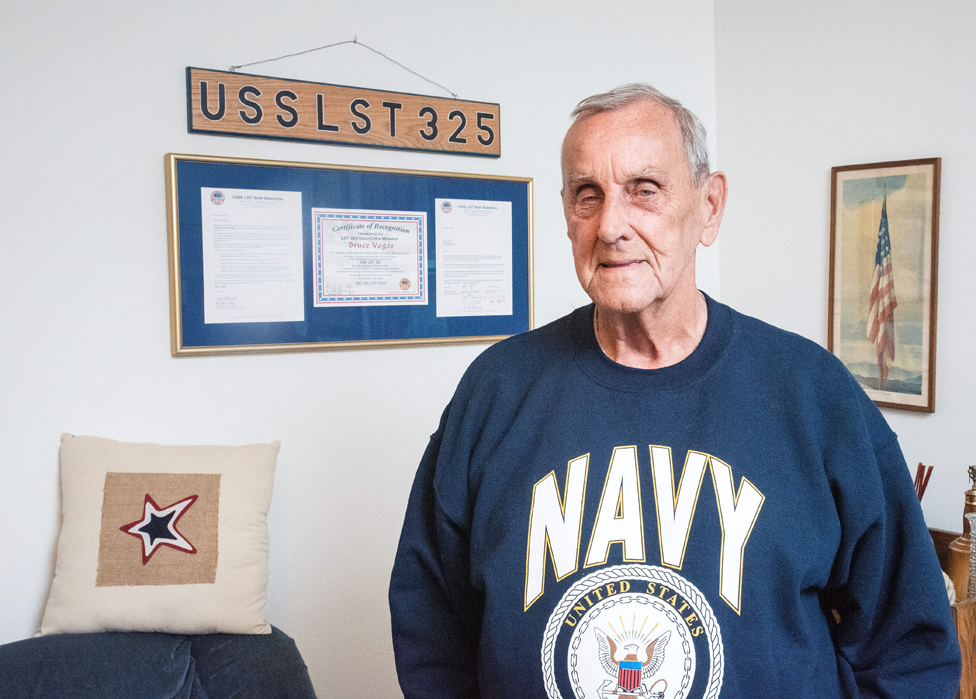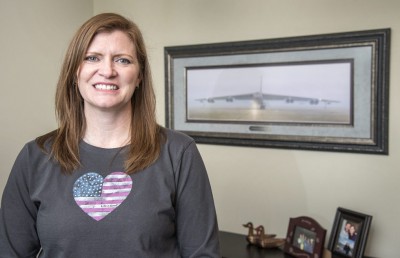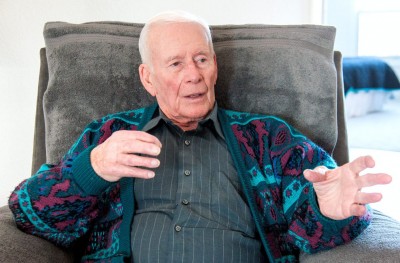Bruce Voges
By Paul Wood

Photo By Rick Danzl/The News-Gazette
ST. JOSEPH — Bruce Voges enlisted in the Navy in 1944 at the age of 17, landed Marines from a small craft on Iwo Jima and Okinawa, witnessed atom-bomb testing and, at the age of 74, brought a restored LST home from Greece.
Voges, 89, served on a Landing Ship Tank, a 328-foot-long vessel designed to take troops, vehicles and cargo directly onto the shore.
During the war, Voges was a bosun’s mate on LST 725, sailing through the Panama Canal to the Pacific as the U.S. gained back islands that had been lost to Japan.
The ship was scrapped immediately after the war, and the one Voges worked on in 2000 was LST 325, which is now in Evansville, Ind.
Voges spent 20 years in the Navy, ending as a computer specialist and retiring in 1964 to work for Magnavox in Urbana.
After his second retirement, he worked his way up from teller to president of the First National Bank of Ogden.
Voges married Katie, who has passed away. They have three grown children, all of whom live in or near St. Joseph.
At 17, the Terre Haute native was patriotic and eager to fight.
Now, he’s reluctant to talk about his heroism in the first landings at Iwo Jima and Okinawa, two islands where the Japanese put up a powerful fight.
“It’s not something I can talk about,” he says.
The Marines began landing at Iwo Jima on Feb. 19, 1945, and had five weeks of bloody fighting in volcanic sand.
A photograph of Marines raising the flag on Mount Suribachi became an iconic image of the war, and a famous statue.
Voges’ ship delivered one of two flags sent up to Mount Suribachi, and nobody’s sure which ship landed the soon-to-be famous one.
But long before that moment, Voges, who left the Navy as a chief petty officer, was in that first wave, bringing Marines in and taking the wounded out.
His first day was closer to 30 hours long. It ran from 7 a.m. to noon the next day.
“Hopefully, you’d get a break for a bologna sandwich and coffee,” he says.
He won’t talk about the fire LST 725 took and the lives the landing cost, only saying he felt for the 18-year-olds who took the beach.
He still has some sand from Iwo Jima.
“You stepped on that island, and your feet sank 8 to 10 inches into the volcanic ash,” he says.
His LST was in the Philippines readying to take on the home islands of Japan when the two atomic bombs were dropped in August.
“I’m thankful President Truman made that decision,” he says.
Voges was home in time for Christmas. He got out of a car, and his father, who didn’t know he was coming, was waiting for him on the front porch.
He was a part of atomic bomb testing done in 1946, viewing it from a ship a dozen miles away. He also served in Korea.
Voges, serving in the China Sea, had an adventure to get back an American pilot who been captured by Mao Zedong’s communist troops.
“We got him back after we delivered a box to the Chinese,” he says. “I don’t know what was in it. I think it may have been penicillin.”
After his three careers, he was back on an LST. Voges was one of 28 men, averaging about 72 years of age, who sailed from Crete in November 2000, arriving to a hero’s welcome in Mobile, Ala., on Jan. 10, 2001.
“The welcome was very moving,” he says. “That’s a trip I’m very glad I made.”
The ship — and its undersized crew — survived a storm near Sicily and the lack of a compass after it broke.
They very occasionally used a GPS device that “went through 10 batteries an hour” to keep on course.
He continued to sail the LST on the Ohio River until 2009. Only 15 of the 28 crew members remain, he says.
Do you know a veteran who could share a story about military service? Contact staff writer Paul Wood at pwood@news-gazette.com.
Read more stories from local veterans:
 Lizabeth Wenzel
MAHOMET — Lt. Col. Lizabeth Wenzel flew an un-manned flight. She was part of a “chick flight” on a B-52, all five crew m …
Lizabeth Wenzel
MAHOMET — Lt. Col. Lizabeth Wenzel flew an un-manned flight. She was part of a “chick flight” on a B-52, all five crew m …
 Ray Heckler
URBANA — With a shell-shocked soldier for a companion, Ray Heckler drove a Jeep near the Rhine River as shells landed al …
Ray Heckler
URBANA — With a shell-shocked soldier for a companion, Ray Heckler drove a Jeep near the Rhine River as shells landed al …
 Mark Williams
CHAMPAIGN — There’s a blessing/curse: “May you live in interesting times.” Mark Williams lived through one. While the wa …
Mark Williams
CHAMPAIGN — There’s a blessing/curse: “May you live in interesting times.” Mark Williams lived through one. While the wa …